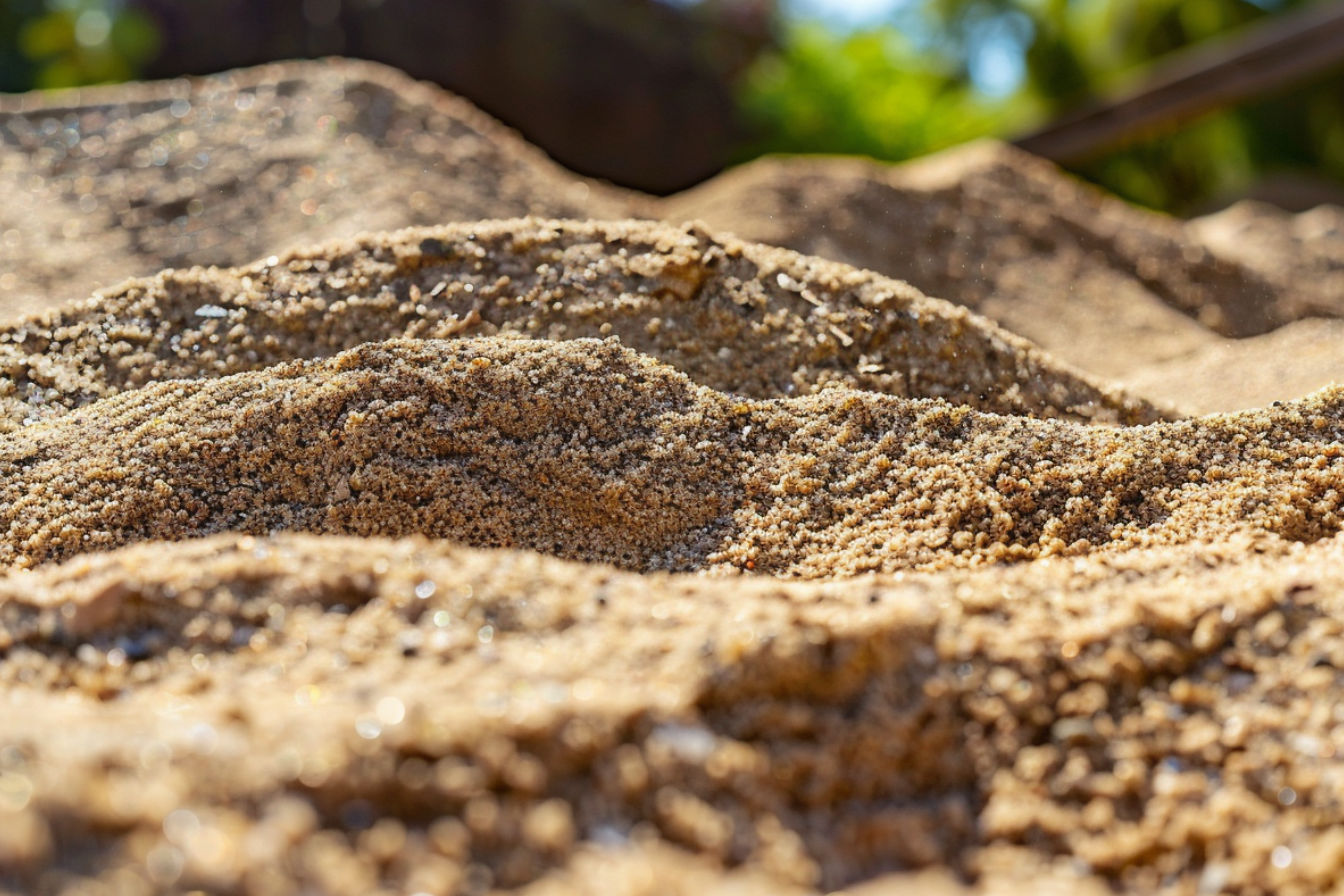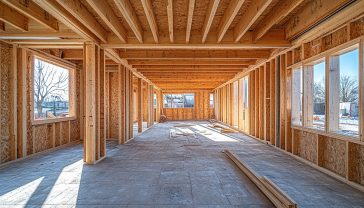What is Sharp Sand? The Gritty Truth
Sharp sand, a seemingly ordinary material, plays a crucial role in various industries. But what exactly is it, and why is it so important?

This post may contain affiliate links. If you make a purchase through these links, we may earn a commission at no additional cost to you.
Sharp sand has been a staple in the construction and landscaping industries for decades. Despite its unassuming appearance, this humble material is vital in creating solid, durable structures and beautiful outdoor spaces. It’s a key ingredient in concrete, mortar, and drainage systems, playing a crucial role in the foundations of our built environment.
But what exactly is it, and how does it differ from the soft, golden sand we associate with beach holidays? The answer lies in its physical characteristics and the way it is produced. Its angular, jagged particles give it unique properties that make it invaluable in various applications.
It’s an unsung hero working behind the scenes, from the towering skyscrapers that define our city skylines to the lush gardens that provide tranquillity. Its versatility and effectiveness have made it an essential component in the construction and landscaping industries, shaping our world.
Sharp Sand Guide
In this article, we’ll explore its unique properties, various applications, and the science behind its effectiveness. We’ll cover the following topics:
By the end of this article, you’ll have a newfound appreciation for this often-overlooked material and its significant impact on our lives. So, let’s dive in and uncover the gritty truth.
Physical Characteristics
To understand what sets sharp sand apart from other types of sand, we must first examine its physical characteristics. Unlike regular beach sand, which tends to have a rounded and smooth texture due to the constant erosion caused by waves and wind, it’s characterised by its angular, jagged particles. These rough edges give it its name and distinct properties.
The angular nature results from how the sand is produced. It’s typically made by crushing rocks like granite or limestone using heavy machinery. This process breaks the rocks into smaller, irregularly shaped particles that retain sharp edges. The size of these particles can vary depending on the intended use of the sand, with coarser grades being used for drainage and finer grades for mortar and concrete mixes.
Sharp Sand Uses in Construction
One of the primary reasons it’s so valued in the construction industry is its ability to create more robust, stable structures. When mixed with cement and water to make concrete or mortar, the angular particles interlock with one another, forming a tight, cohesive matrix. This interlocking effect helps distribute the structure’s weight evenly and prevents the formation of weak points or voids that could compromise its integrity.
In addition to its structural benefits, sharp sand plays a crucial role in drainage applications. Its angular particles create spaces between the grains, allowing water to flow more quickly than with rounded sand particles. This property makes it an ideal choice for use in the construction of drainage systems, septic leach fields, and even as a base layer for pavers and other outdoor surfaces.
Sharp Sand Landscaping Applications
While primarily associated with construction, its unique properties make it a valuable asset in landscaping. Landscaping professionals and gardening enthusiasts have discovered the benefits of incorporating it into their outdoor projects.
One of the most common uses in landscaping is as a top dressing for lawns and gardens. By spreading a thin layer of over the soil surface, gardeners can improve soil structure and promote better plant growth conditions. The angular particles help to break up compacted soil, allowing for better aeration and drainage. This is particularly beneficial in areas with heavy, clay-rich soils that tend to retain moisture and hinder root development.
In addition to improving soil structure, it can also help to deter pests and discourage weed growth. The abrasive nature of the sand particles can create an inhospitable environment for slugs, snails, and other garden pests, making it more difficult for weeds to take root and spread.
Beyond its practical applications, sharp sand is also valued for its aesthetic qualities in landscaping. Its coarse, gritty texture and varied shades of grey, brown, and tan can add visual interest and contrast to garden beds, pathways, and other landscape features.
One use is in the creation of rock gardens and Zen gardens. These low-maintenance, visually striking garden styles often rely on gravel, stones, and sand to create intricate patterns and designs. Its angular particles and natural colour variations make it an ideal choice for these applications, as it can be raked and shaped into mesmerizing swirls and furrows that mimic the flow of water or the ripples of dunes.
In rock gardens, it can be used as a mulch around plants, helping to retain moisture and suppress weed growth while also providing a visually appealing contrast to the rough textures of the rocks and boulders. The sand’s reflective quality can also help bounce light back onto the plants, enhancing their colours and textures.
When using it in landscaping applications, choosing the appropriate grade and particle size for the specific project is essential. Coarser grades may be better suited for drainage and mulching, while finer grades can be used for top dressing and creating intricate designs in Zen gardens.
As with any landscaping material, it’s crucial to source sharp sand from reputable suppliers to ensure that it is free from contaminants and meets the necessary quality standards for your project. With its unique properties and versatile applications, it can be valuable in creating beautiful, functional, and low-maintenance outdoor spaces that enhance our connection to nature.
Sharp Sand Quality and Suitability
Not all sharp sand is created equal. The quality and suitability for a particular project can vary depending on factors such as the source of the sand, the type of rock it was derived from, and the processing methods used. To ensure the best possible results, contractors and DIY enthusiasts must carefully select the appropriate grade and quality.
One of the primary factors influencing the quality is the source from which it is obtained. It’s typically derived from crushed rocks, such as granite, limestone, or sandstone, and the specific type of rock can significantly impact the sand’s properties.
For example, that derived from granite tends to be harder and more durable than sand sourced from softer rocks like limestone. This makes granite-based sharp sand a better choice for applications requiring high strength and wear resistance, such as concrete mixes and drainage systems.
In addition to the type of rock, the geological location and environmental conditions of the sand’s source can also affect its quality. Sand sourced from regions with high levels of natural contaminants, such as clay, silt, or organic matter, may require extensive processing to remove these impurities before they can be used in construction or landscaping applications. Failure to adequately clean and grade the sand can result in weaker, less durable structures or poor drainage performance.
The processing methods used to create it can also significantly impact its quality and suitability for different projects. The crushing, screening, and washing processes used to transform raw rock can vary widely between suppliers, and these differences can affect the size, shape, and consistency of the resulting sand particles.
For example, sand that has been insufficiently washed may contain excess dust or fine particles that can interfere with the bonding process in concrete mixes, leading to weaker, less durable structures. Similarly, sand that has been over-crushed may contain too many fine particles, which can negatively impact drainage performance in landscaping applications.
Consider factors such as:
- The intended application (e.g., concrete, mortar, drainage, landscaping)
- The desired strength, durability, and performance characteristics
- The specific mix design or installation requirements
- Local building regulations governing the use of sand in construction
It’s also worth noting that the quality and suitability of sharp sand can have significant economic implications for construction and landscaping projects. Using lower-grade or unsuitable sand may result in costly repairs, replacements, or redesigns, offsetting initial material savings. By investing in quality, project owners can help minimise long-term costs and ensure the success and longevity of their investments.
Environmental Concerns of Sharp Sand
As the construction industry grows and urbanisation expands globally, the demand and other construction materials has reached unprecedented levels. However, this increased demand has also highlighted the significant environmental challenges associated with sand mining, including the extraction.
One of the primary concerns surrounding sharp sand extraction is the potential for widespread ecological damage. Many sand mining operations occur in sensitive ecosystems, such as riverbeds, coastlines, and marine environments, home to diverse plant and animal species. Removing large quantities of sand can disrupt these delicate habitats, leading to erosion, loss of biodiversity, and changes in water flow patterns.
For example, in-stream sand mining, which involves extracting sand directly from river channels, can alter the morphology and hydrology of the river system. This can lead to increased water turbidity, reduced water quality, and changes in the river’s ability to support aquatic life. In coastal regions, sand mining can contribute to beach erosion and destroy critical coastal habitats, such as coral reefs and seagrass beds.
In addition to directly impacting ecosystems, mining can have significant consequences for local communities that depend on these natural resources for their livelihoods. In many regions, sand mining operations have led to the displacement of local populations, the loss of traditional fishing and farming practices, and the degradation of important cultural and heritage sites.
The growing awareness of these environmental and social challenges has prompted many countries to implement regulations and guidelines to promote more sustainable and responsible sand mining practices.
These efforts often focus on several key areas, including:
- Establish clear environmental impact assessment (EIA) procedures to evaluate the potential consequences of sand mining operations before approval.
- Implement strict monitoring and enforcement mechanisms to ensure mining companies adhere to environmental regulations and best practices.
- Encouraging alternative materials and construction techniques that reduce the demand and other mined resources.
- Investing in research and development efforts aimed at finding more sustainable and eco-friendly sources of construction materials.
- Promoting greater transparency and public participation in decision-making processes related to sand mining and resource management.
Despite these efforts, the challenges of sustainable resource management remain significant. As global demand for construction materials continues to rise, it will be increasingly important for governments, industry leaders, and civil society organisations to work together to find innovative solutions that balance economic development with environmental protection and social responsibility.
This may involve exploring new technologies and production methods that minimize the environmental footprint of extraction, such as using recycled materials or developing alternative binding agents that reduce the need for sand in concrete production. It may also require a fundamental shift in how we think about resource consumption and economic growth, moving away from the traditional “take-make-dispose” model and towards a more circular and regenerative approach.
Addressing the environmental concerns associated with sharp sand mining will require a concerted effort from all stakeholders, including governments, industry, academia, and civil society.
By working together to promote sustainable practices, invest in research and innovation, and raise awareness about the importance of responsible resource management, we can help to ensure that the benefits of sharp sand and other construction materials are realised without compromising the health and resilience of our planet’s ecosystems and communities.
Future Outlook
As our world continues to evolve and our cities and communities grow, the demand for sharp sand and other construction materials will likely remain strong. However, in light of the increasing environmental and social challenges associated with sand mining, it’s clear that a business-as-usual approach is no longer viable. We must embrace new ways of thinking and working with this vital resource to ensure a sustainable future for our built environment and the natural world that supports it.
One key area of focus in the years ahead will be developing and adopting innovative construction techniques that reduce our reliance on virgin sharp sand. This may involve the increased use of recycled and reclaimed materials, such as crushed concrete and glass, which can partially replace it in certain applications.
By finding ways to reuse and repurpose existing materials, we can help minimize the environmental impact of construction while also reducing waste and conserving natural resources.
Another essential strategy will be the exploration of alternative materials that can substitute in specific contexts. For example, some researchers and companies are investigating the potential of using engineered wood products, such as cross-laminated timber (CLT), as a low-carbon alternative to concrete in certain building applications.
While these materials may not be suitable for all projects, they represent an important avenue for innovation and experimentation in the quest for more sustainable construction practices.
In addition to these technological and material innovations, supporting responsible and sustainable mining practices will be crucial to the future. This will require a concerted effort from governments, industry leaders, and civil society organizations to develop and enforce robust environmental and social standards for sand mining operations.
By ensuring that mining companies adhere to best practices and are held accountable for their impacts on local communities and ecosystems, we can help mitigate the negative consequences of sand extraction while still meeting the demand for this critical resource.
Achieving a sustainable future for sharp sand will also require a shift in how we think about resource consumption and economic growth more broadly. This may involve moving away from the traditional linear resource extraction, use, and disposal model and towards a more circular and regenerative approach that prioritizes the long-term health and resilience of our planet and its inhabitants.
In practice, this could mean embracing concepts like “urban mining,” where the built environment is viewed as a source of valuable materials that can be recovered and reused at the end of a building’s life cycle. It could also involve investing in research and development efforts to create more efficient and sustainable production processes, such as using renewable energy in mining and manufacturing operations.
Ultimately, the future will depend on our ability to balance the competing demands of economic development, environmental protection, and social responsibility. By embracing a mindful and holistic approach to this valuable resource and working together to drive innovation and change, we can help ensure that the benefits are enjoyed for generations to come without compromising the health and well-being of our planet and its people.
As we move forward, all stakeholders—from individual consumers and construction professionals to policymakers and industry leaders—will need to stay informed about the latest developments and best practices.
By sharing knowledge, collaborating across sectors, and pushing for positive change, we can help build a future in which using sharp sand and other construction materials is efficient and practical, environmentally and socially responsible.
Challenges and Safety Considerations
While it’s invaluable in construction and landscaping, working with it presents some challenges and potential hazards. The properties that make it so effective in creating solid and durable structures (and visually appealing landscapes) can also pose risks to those handling it.
One of the primary challenges of working with sharp sand is its abrasive nature. The angular, jagged particles can cause significant wear and tear on equipment and tools, notably softer materials like rubber or plastic. Over time, repeated exposure can lead to premature deterioration of conveyor belts, hoses, and other components in sand processing and delivery systems. This can result in increased maintenance costs and potential downtime for repairs.
In addition to the impact on equipment, the abrasive properties can also pose safety risks to workers. The jagged particles can easily scratch or cut skin, leading to minor injuries if proper protective gear is not worn. Eye injuries are a concern, as the fine dust created when handling or processing it can irritate the eyes and cause vision problems if left unchecked.
To mitigate these risks, it’s crucial for those working with sharp sand to follow appropriate safety protocols and wear the necessary personal protective equipment (PPE). This includes:
- Sturdy, cut-resistant gloves to protect the hands and fingers from abrasions and cuts.
- Safety glasses or goggles to shield the eyes from dust and debris.
- Long-sleeved clothing and full-length pants to minimize skin exposure.
- Dust masks or respirators to prevent the inhalation of fine sand particles, which can cause respiratory issues over time.
In addition to PPE, it’s essential to maintain a clean and organised work environment when dealing with it. Regular housekeeping practices, such as sweeping up spills and using dust collection systems, can help minimize the accumulation of loose sand particles contributing to slips, trips, and falls.
Proper training and education are also key factors in safely handling. Workers should be trained on the potential hazards associated with the material and the correct methods for storing, transporting, and using it in various applications. This includes learning to properly operate and maintain equipment, such as sanders, grinders, and mixing machines, to minimize the risk of accidents and injuries.
Another challenge when working is the potential for environmental impact. As mentioned earlier, the increasing demand for sand has led to concerns about the sustainability and ecological consequences of sand mining practices. It’s vital to be aware of these issues and to minimize their environmental footprint whenever possible. This may involve sourcing sand from responsibly managed quarries, implementing recycling and waste reduction strategies, and adhering to local regulations and best practices for sand use and disposal.
By understanding the challenges and potential hazards associated with it and taking appropriate measures to ensure worker safety and environmental responsibility, professionals in the construction and landscaping industries can continue to harness the unique properties of this valuable material while minimizing negative impacts on human health and the natural world.
Conclusion
Throughout this article, we have explored the multifaceted world of sharp sand, from its unique physical properties and diverse applications to the challenges and opportunities associated with its use and extraction. This seemingly humble material plays a vital role in shaping our built environment and supporting the growth and development of our communities.
However, as we have seen, the increasing demand and other construction materials has brought to light the significant environmental and social challenges of sand mining. The impacts of our reliance on sharp sand are far-reaching and complex, from the destruction of sensitive ecosystems and the displacement of local communities to the greenhouse gas emissions associated with cement production.
Addressing these challenges will require a fundamental shift in how we think about and use this valuable resource. It will involve embracing innovative technologies and materials that reduce our dependence on virgin sharp sand, supporting responsible and sustainable mining practices, and working together to promote a more circular and regenerative approach to construction and resource management.
At the same time, we must recognise that the transition to a more sustainable future will not happen overnight. It will require sustained effort, collaboration, and commitment from all stakeholders, including governments, industry leaders, researchers, and civil society organizations. We must be willing to invest in research and development, to support policies and regulations that incentivize sustainable practices, and to educate and engage the public about the importance of responsible resource management.
Despite the challenges, there is reason for hope. Around the world, there are countless examples of individuals, companies, and communities working to drive positive change in how we use and manage it and other construction materials. From developing low-carbon concrete alternatives to adopting circular economy principles in building design and construction, these efforts demonstrate that a more sustainable future is within reach.
As we look ahead, it is clear that the story of sharp sand is far from over. This remarkable material will continue to play a vital role in shaping our world and supporting the growth and development of our societies. But it is up to all of us to ensure that this story is one of balance, responsibility, and stewardship – a story in which the benefits are enjoyed not just for years but for generations to come.
So let us embrace this challenge with the same ingenuity, determination, and care that have always been the hallmarks of our built environment. Let us work together to create a future in which using it and other precious resources is not a source of environmental and social harm but rather a sustainable and responsible development model. And let us never forget the vital role that this humble yet mighty material plays in shaping the world we inhabit.
In the end, the story of sharp sand is not just about material—it is about our relationship with the natural world, our commitment to the well-being of our communities, and our vision for a more sustainable and resilient future. By understanding this story and working together to write its next chapter, we can help ensure that its legacy is one of innovation, responsibility, and hope.






